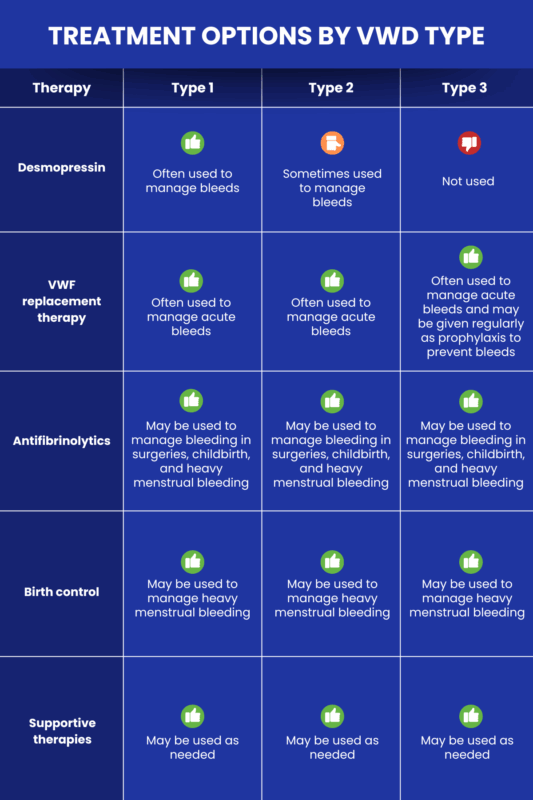
Von Willebrand disease treatment: What to expect and how it helps
Last updated June 30, 2025, by Marisa Wexler, MS

Von Willebrand disease (VWD) is a disorder that’s marked by bleeding that is unusually easy, heavy, and prolonged. Treatment for von Willebrand disease focuses on preventing and controlling bleeds, which can minimize the risk of serious complications and help patients have a better quality of life.
Main treatment options
VWD is caused by problems with a protein called von Willebrand factor (VWF), which normally helps the blood to clot. People with VWD have either lower than normal levels of this protein, abnormal forms of VWF that don’t work correctly, or no VWF at all.
The main treatments used for von Willebrand disease aim to boost VWF protein levels to restore blood clotting. There also are treatments that help normalize blood clotting through other mechanisms, as well as therapies that help manage specific manifestations of the disease.
Based on recent guidelines, Von Willebrand disease treatment may involve:
- desmopressin, which increases VWF protein levels and may be used for managing bleeding episodes in people with milder forms of VWD
- VWF replacement therapy, which involves administering a functional version of the protein and is used to manage more serious bleeds and prevent bleeds in people with severe forms of the disease
- antifibrinolytics, which prevent blood clots from breaking down and may be used to control some types of bleeds
- birth control, which can be used to manage heavy menstrual bleeding
- other supportive treatments to manage specific disease symptoms.
Desmopressin
Desmopressin is one of the most commonly used treatments for von Willebrand disease. It works by prompting the release of stored VWF into the bloodstream, which can help normalize blood clotting in people who have milder forms of VWD. It also can be used to manage milder bleeds associated with surgery, trauma, or those occurring spontaneously.
Brands of desmopressin that have been specifically approved in the U.S. to manage bleeding in VWD include:
- DDAVP, which is administered intravenously, or by an infusion directly into the bloodstream
- Stimate, which is administered nasally, by spraying into the nose, but is currently unavailable following a market recall.
Before starting treatment with desmopressin, it’s recommended that patients undergo a so-called desmopressin trial, in which a dose of desmopressin is administered and then a doctor measures how VWF protein levels change over the next several hours. If VWF levels increase as expected, then desmopressin may be used to manage future bleeds. For people who fail to respond to desmopressin, other therapies are required.
VWF replacement therapy
Von Willebrand factor replacement therapy involves administering a working version of the VWF protein into the body to restore blood clotting. Some VWF replacement therapies also contain another clotting protein, called factor VIII (FVIII).
VWF replacement therapies are all administered by intravenous injection. They are commonly used as an on-demand treatment to manage more serious bleeding episodes in people with more severe forms of VWD, or for those with milder forms who don’t respond to desmopressin. VWF replacement therapies also may be given regularly as prophylaxis to prevent bleeds in people with a history of frequent and severe bleeds.
Among the VWF replacement therapies now approved in the U.S. are:
- Alphanate, Humate-P, and Wilate, all of which contain VWF and FVIII proteins derived from human blood
- Vonvendi, which contains a lab-made or recombinant version of VWF.
Antifibrinolytics
Antifibrinolytic therapy works to promote blood clotting by preventing clots from breaking down. These medications, which are available in several formulations — including injectable and oral forms — may be used to help manage bleeds occurring during and after surgeries or dental procedures. They may also be used to help manage heavy menstrual bleeding and to prevent excessive bleeding following childbirth.
Examples of antifibrinolytics that may be used in VWD include:
- aminocaproic acid, sold as Amicar
- tranexamic acid, sold under the brand names Cyklokapron and Lysteda.
Birth control
Birth control pills and/or intrauterine devices (IUDs) may be used to help manage heavy menstrual periods in von Willebrand disease. These treatments can help reduce the growth of the endometrium — the lining of the uterus that’s normally shed during the menstrual cycle. Contraceptive pills containing estrogen can also help increase VWF and FVIII levels, and minimize menstrual blood loss.
Supportive treatments
Other supportive treatments that may be used in people with VWD include:
- nasal sprays and gels to keep the nose moist and reduce the risk of nosebleeds
- iron supplements, which may be used in individuals who develop iron deficiency due to blood loss
- topical hemostatic agents, which are applied to the skin to stop bleeding and may be used to manage certain types of bleeds.

Emergency and preventive treatment strategies
Because people with VWD are prone to easy and prolonged bleeding, special consideration is needed in situations, such as surgeries and childbirth, where bleeding is likely to happen.
Considerations for surgery and childbirth
Before surgery, it’s recommended that people with VWD consult a specialist with expertise in von Willebrand disease and surgery to go over the potential risks and develop a personalized treatment plan to minimize and control bleeding.
People with VWD should receive multidisciplinary care during pregnancy to minimize risks for the mother and the child. During the third trimester, pregnant women with von Willebrand disease should undergo testing to measure VWF activity levels. Depending on how these levels have fluctuated during pregnancy, patients may receive additional treatments to minimize the risk of serious bleeding.
It’s also recommended that patients receiving neuraxial anesthesia, known as a spinal block, during labor be given VWF replacement treatment. In the days after childbirth, it’s common for people with VWD to receive antifibrinolytics to reduce the risk of postpartum bleeding.
Emergency care
When people with von Willebrand disease experience acute bleeding, it’s generally recommended that they receive treatment with a VWF replacement therapy. Sometimes antifibrinolytics may also be given as an adjunctive treatment.
Patients are recommended to work with their healthcare providers to proactively come up with plans for managing acute bleeds. In some cases, patients may be equipped with VWF replacement therapy to be administered at home when acute bleeds occur, though home infusion therapy should only be done after patients have received appropriate training from a healthcare expert.
Special considerations by VWD type
There are three main types of von Willebrand disease:
- type 1, in which VWF protein levels are abnormally low
- type 2, where the VWF protein is abnormal and doesn’t function correctly
- type 3, where there is no detectable VWF protein.
Desmopressin, a common treatment for VWD, only works if patients are able to produce a functional version of VWF. As such, this medication is:
- generally effective as a type 1 von Willebrand disease treatment
- sometimes, but not always, effective as a type 2 von Willebrand disease treatment
- typically ineffective as a type 3 von Willebrand disease treatment.
Although most patients with type 1 von Willebrand disease will respond to desmopressin, those with a specific subtype called type 1C often will not.
Because patients can have variable responses to desmopressin, it’s recommended that all undergo a trial to ensure that the therapy increases VWF levels before it is used for managing bleeds. This trial recommendation doesn’t apply to patients with type 3 VWD due to the anticipated lack of efficacy, and to those with some forms of type 2 VWD due to potential complications.
VWF replacement therapies and other treatments for von Willebrand disease can generally be used across all disease types. People with type 3 von Willebrand disease often require prophylactic VWF replacement therapy to reduce the risk of future bleeds.
Monitoring and adjusting treatment
To properly monitor the efficacy of mainstay treatments, such as desmopressin and VWF replacement therapy, clinicians will measure VWF activity levels in the blood. To control bleeding, it’s recommended that VWF activity be increased to at least 30% of what’s normally seen in people who don’t have von Willebrand disease. Specifically, VWF activity levels of 50% or higher are considered ideal. Clinicians will also monitor patients for signs of bleeding and discuss whether an individual’s symptoms are being adequately controlled.
If a treatment is not increasing VWF adequately or symptoms are not being effectively controlled, it may be necessary to change the treatment plan — for example, by switching to a different type of treatment or adding a new therapy.
It’s also important to note that, like any therapy, treatments for von Willebrand disease may cause side effects. For instance, desmopressin can cause fluid retention and its use has been associated with seizures and low blood sodium levels, known as hyponatremia. The therapy is also generally not recommended to be used by people with cardiovascular disease and/or at high risk of thrombosis, or blood clots blocking blood flow.
Moreover, a small percentage of patients treated with VWF clotting factor concentrates may develop neutralizing antibodies against the VWF protein that may prevent replacement therapies from working adequately. If these antibodies develop, additional therapies may be needed to effectively control bleeding.
Bleeding Disorders News is strictly a news and information website about the disease. It does not provide medical advice, diagnosis, or treatment. This content is not intended to be a substitute for professional medical advice, diagnosis, or treatment. Always seek the advice of your physician or other qualified health provider with any questions you may have regarding a medical condition. Never disregard professional medical advice or delay in seeking it because of something you have read on this website.
Recent Posts
- ITP treatment Doptelet may help prevent bone loss in osteoporosis
- Bleeding risk high soon after kidney transplant in VWD, hemophilia A
- Combined therapy aids recovery for woman with TTP and lupus
- An ITP diagnosis wasn’t the final word on my health setbacks
- Cell therapy QT-019B shows strong response rate in hard-to-treat ITP
Related articles
-

-
-

THROMBOTIC THROMBOCYTOPENIC PURPURA
NewsCombined therapy aids recovery for woman with TTP and lupus
-
-
-




